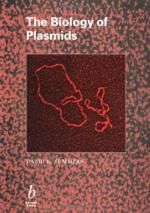|
This section contains 392 words (approx. 2 pages at 300 words per page) |
Plasmids are extra-chromosomal, covalently closed circular (CCC) molecules of double stranded (ds) DNA that are capable of autonomous replication. The prophages of certain bacterial phages and some dsRNA elements in yeast are also called plasmids, but most commonly plasmids refer to the extra-chromosomal CCC DNA in bacteria.
Plasmids are widely distributed in nature. They are dispensable to their host cell. They may contain genes for a variety of phenotypic traits, such as antibiotic resistance, virulence, or metabolic activities. The products plasmids encode may be useful in particular conditions of bacterial growth. Replication of plasmid DNA is carried out by subsets of enzymes used to duplicate the bacterial chromosome and is under the control of plasmid's own replicon. Some plasmids reach copy numbers as high as 700 per cell, whereas others are maintained at the minimal level of 1 plasmid per cell. One particular type of plasmid has the ability to transfer copies of itself to other bacterial stains or species. These plasmids have a tra operon. Tra operon encodes the protein that is the component of sex pili on the surface of the host bacteria. Once the sex pili contact with the recipient cells, one strand of the plasmid is transferred to the recipient cells. This plasmid can integrate into the host chromosomal DNA and transfer part of the host DNA to the recipient cells during the next DNA transfer process.
Plasmids are essential tools of genetic engineering. They are used as vectors in molecular biology studies. Ideally, plasmids as vectors should have three characteristics. First, they should have a multiple cloning site (MSC) which consists of multiple unique restriction enzyme sites and allows the insertion of foreign DNA. Second, they should have a relaxed replication control that allows sufficient plasmids to be produced. Last, plasmids should have selectable markers, such as antibiotics metabolite genes, which allow the identification of the transformed bacteria. Numerous plasmid vectors have been developed since the first plasmid vectors of the early 1970s. Some vectors have bacteriophage promoter sequences flanking the MSC that allows direct sequencing of the cloned DNA sequence. Some vectors have yeast or virus replication origin, which allows the plasmids to replicate in yeast and mammalian cells, hence enabling cloned cDNAs to express in these host cells. Many new features have and will be added into plasmids to make genetic engineering easier and faster.
|
This section contains 392 words (approx. 2 pages at 300 words per page) |


